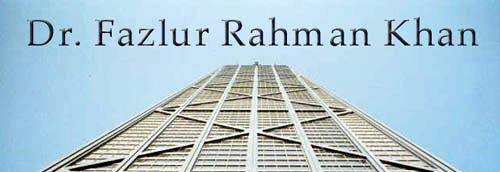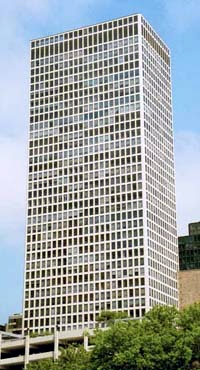| |

Innovation Follows Program
World population by 1960 was about to burst at the seams. Or so it
seemed. Capping the dramatic population increases of the first half of the 20th
century, the 1950s' baby boom intensified people’s sense of an earth that
was shrinking. Metropolitan centers in particular were pressed for space.
Housing was needed
| |
| |

|
| |
| |
The revolutionary framed-tube structural system was first seen in the construction of the DeWitt-Chestnut Apartments.
|
| |
for a large number of people — single-family homes
were not sufficient — and office space was also wanted for the spiraling
numbers of office workers. A healthy economy ensured a sustained demand for
office space.
High-rise construction offered the perfect solution. Super-tall
buildings could provide large amounts of floor area without having to be
densely packed, one building upon the next. A portion of each city block that a
high rise occupied could be left available for desirable city plazas and parks.
Despite these apparent advantages, super-tall building
construction faced a critical deterrent: expense. Skyscrapers were simply too
costly by modern development standards. A tower reaching as high as the Empire
State Building could not be justified in economic terms.
It was a generally accepted "fact" of construction that
taller buildings cost more to build per square foot of rentable floor area than
shorter buildings. A rapid run-up in structure costs resulted from increased
wind forces: in order to withstand greater wind effects, a tower's structural
framework had to be strengthened and stiffened considerably with increasing
building height. Developers, therefore, were dissuaded from building above the
thirty-story range by this cost premium. They leaned instead toward
constructing bulky, site-consuming edifices. It appeared that conditions in
central business districts were bound to worsen, with every building site being
completely filled.
It was at this critical moment in the development of the modern
urban environment that Fazlur Khan entered the profession.
Filled with both ambition and optimism, and equipped with solid
training in structural engineering, Fazlur Khan was undeterred by the
mindset and technological difficulties that hindered tall building design.
He recognized that the structural systems utilized for high-rise construction
were not on a par with the modern scale of architecture,
| |

|
| |
|
In 1960, buildings over 20 stories were still newsworthy; by the close of the decade, people were "living in the sky." Apartments in the John Hancock Center in Chicago are located as high as the 90th floor.
|
| | |
and he took
on the challenge of advancing state-of-the-art structural engineering. A decade
of revolutionary advances had just begun.
Fazlur Khan's earliest contributions to the field — developing the
shear wall frame interaction system, the framed-tube structure, and the
tube-in-tube structure —
| |
| |

|
| |
| |
The Onterie Center in Chicago interpreted the trussed-tube structural system for reinforced concrete construction.
|
| |
led to significant improvement in structural
efficiency: they made the construction of tall buildings economically feasible.
The framed-tube structure has its columns closely spaced around the perimeter
of the building, rather than scattered throughout the footprint, while stiff
spandrel beams connect these columns at every floor level. This structural
system was first implemented in 1964 in the construction of the DeWitt-Chestnut
Apartments in Chicago, a 43-story reinforced concrete tower designed by Fazlur
Khan and his colleagues at Skidmore, Owings & Merrill (SOM). Because of its
great relative strength and stiffness, the tubular form immediately became a
standard in high-rise design.
As the reach of tall buildings extended, Fazlur Khan resolved to
discover structural systems appropriate for each new scale of architecture.
Crafting rational architecture in cooperation with Bruce J. Graham, chief
design architect in SOM's Chicago office, he united an exceptionally efficient
"trussed-tube" structural system with an articulate, graceful form
for Chicago's 100-story John Hancock Center.
| |

|
| |
|
Looking up at the Sears Tower, the world's tallest building for over twenty years. The design for this 1450-foot-tall tower introduced the bundled tube structural system, as well as a new vocabulary in architectural form.
|
| | |
A few years later he introduced another groundbreaking structural
system, the "bundled tube." This design for Chicago's 110-story Sears
Tower was structurally efficient and economic: at 1,450 feet, it provided more
space and rose higher than the Empire State Building, yet cost much less per
unit area. Equally important, the new structure type was innovative in its
potential for versatile formulation of architectural space. Efficient towers no
longer had to be box-like; the tube-units could take on various shapes and
could be bundled together in different sorts of groupings.
When one looks at a text on tall-building design today, one finds
these recognizable structure types: the framed tube, the shear wall frame
interaction, the trussed tube, the bundled tube, and the composite system (also
developed by Fazlur Khan). Though Khan developed structural systems for
particular project needs, he based his innovations on fundamental structural
principles that allowed them wide application. His developments are among
today’s “conventional” systems for skyscraper design.
| |
| |

|
| |
| |
Saudi Arabia celebrated its new airport terminal in a postage stamp design.
|
| |
As the building boom in the West came to an abrupt halt in 1974,
new demands surfaced that thrust designers into unfamiliar settings. Clients in
the Middle East and Asia, for example, were anxious and now financially able to
construct housing, offices, and other facilities in large scale. SOM took on
this design work, and Fazlur Khan responded to needs and situations as he
perceived them.
For the immense roof of the Hajj Terminal of the new airport in Jeddah,
Saudi Arabia — intended to shelter 80,000 pilgrims at a time, waiting
for up to 36 hours — he searched for a coherent scheme that was both
efficient and honored the spirit of the Hajj pilgrimage. The fabric roof
structure melds a traditional concept, that of the Bedouin tent, with
sophisticated technology. Twenty years after the airport's opening, this
fabric roof and the space that it creates continue to awe as well as comfort
terminal users.
|

